Child Development L3 Project: Stages, Influences & Theorists
VerifiedAdded on 2023/06/11
|22
|5090
|418
Project
AI Summary
This child development project comprehensively explores various stages of development from conception to adolescence, detailing physical, cognitive, emotional, social, behavioral, and linguistic milestones. It examines the normal pattern of fetal development, highlighting factors influencing fetal and brain development, such as genetics, nutrition, and environmental conditions. The project also discusses the impact of external factors on health, wellbeing, and development, considering both positive and negative influences. Furthermore, it addresses speech and language difficulties, offering insights into conditions affecting language development and strategies for support, including the impact of bilingualism. Finally, the project delves into the theories of Dr. Suzanne Zeedyk and Albert Bandura, examining their perspectives on pre- and post-natal care, mental health, family structure, discrimination, domestic violence, and poverty. This student contributed project is available on Desklib, a platform offering a wide range of study resources and AI-based tools for students.
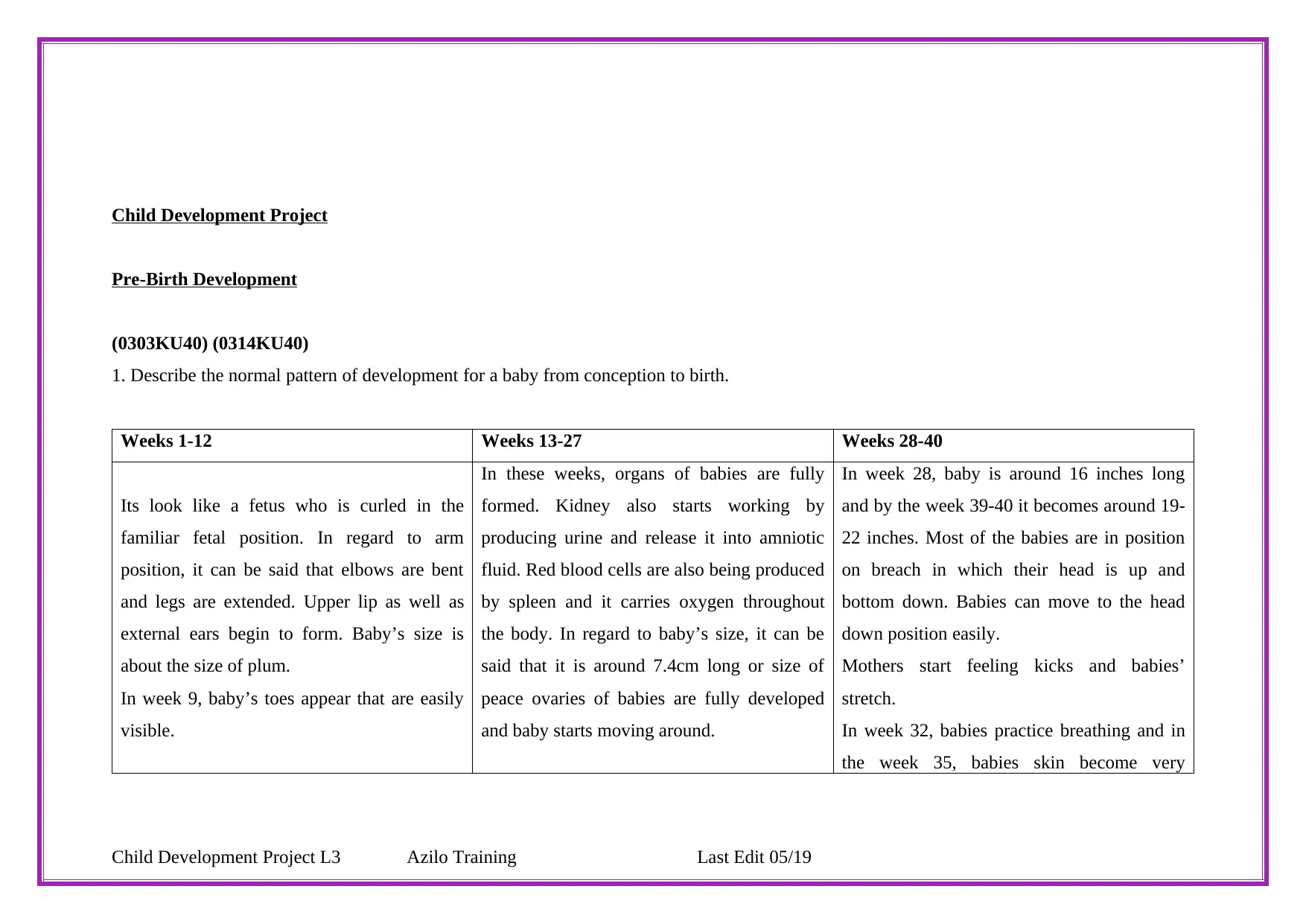
Child Development Project
Pre-Birth Development
(0303KU40) (0314KU40)
1. Describe the normal pattern of development for a baby from conception to birth.
Weeks 1-12 Weeks 13-27 Weeks 28-40
Its look like a fetus who is curled in the
familiar fetal position. In regard to arm
position, it can be said that elbows are bent
and legs are extended. Upper lip as well as
external ears begin to form. Baby’s size is
about the size of plum.
In week 9, baby’s toes appear that are easily
visible.
In these weeks, organs of babies are fully
formed. Kidney also starts working by
producing urine and release it into amniotic
fluid. Red blood cells are also being produced
by spleen and it carries oxygen throughout
the body. In regard to baby’s size, it can be
said that it is around 7.4cm long or size of
peace ovaries of babies are fully developed
and baby starts moving around.
In week 28, baby is around 16 inches long
and by the week 39-40 it becomes around 19-
22 inches. Most of the babies are in position
on breach in which their head is up and
bottom down. Babies can move to the head
down position easily.
Mothers start feeling kicks and babies’
stretch.
In week 32, babies practice breathing and in
the week 35, babies skin become very
Child Development Project L3 Azilo Training Last Edit 05/19
Pre-Birth Development
(0303KU40) (0314KU40)
1. Describe the normal pattern of development for a baby from conception to birth.
Weeks 1-12 Weeks 13-27 Weeks 28-40
Its look like a fetus who is curled in the
familiar fetal position. In regard to arm
position, it can be said that elbows are bent
and legs are extended. Upper lip as well as
external ears begin to form. Baby’s size is
about the size of plum.
In week 9, baby’s toes appear that are easily
visible.
In these weeks, organs of babies are fully
formed. Kidney also starts working by
producing urine and release it into amniotic
fluid. Red blood cells are also being produced
by spleen and it carries oxygen throughout
the body. In regard to baby’s size, it can be
said that it is around 7.4cm long or size of
peace ovaries of babies are fully developed
and baby starts moving around.
In week 28, baby is around 16 inches long
and by the week 39-40 it becomes around 19-
22 inches. Most of the babies are in position
on breach in which their head is up and
bottom down. Babies can move to the head
down position easily.
Mothers start feeling kicks and babies’
stretch.
In week 32, babies practice breathing and in
the week 35, babies skin become very
Child Development Project L3 Azilo Training Last Edit 05/19
Paraphrase This Document
Need a fresh take? Get an instant paraphrase of this document with our AI Paraphraser
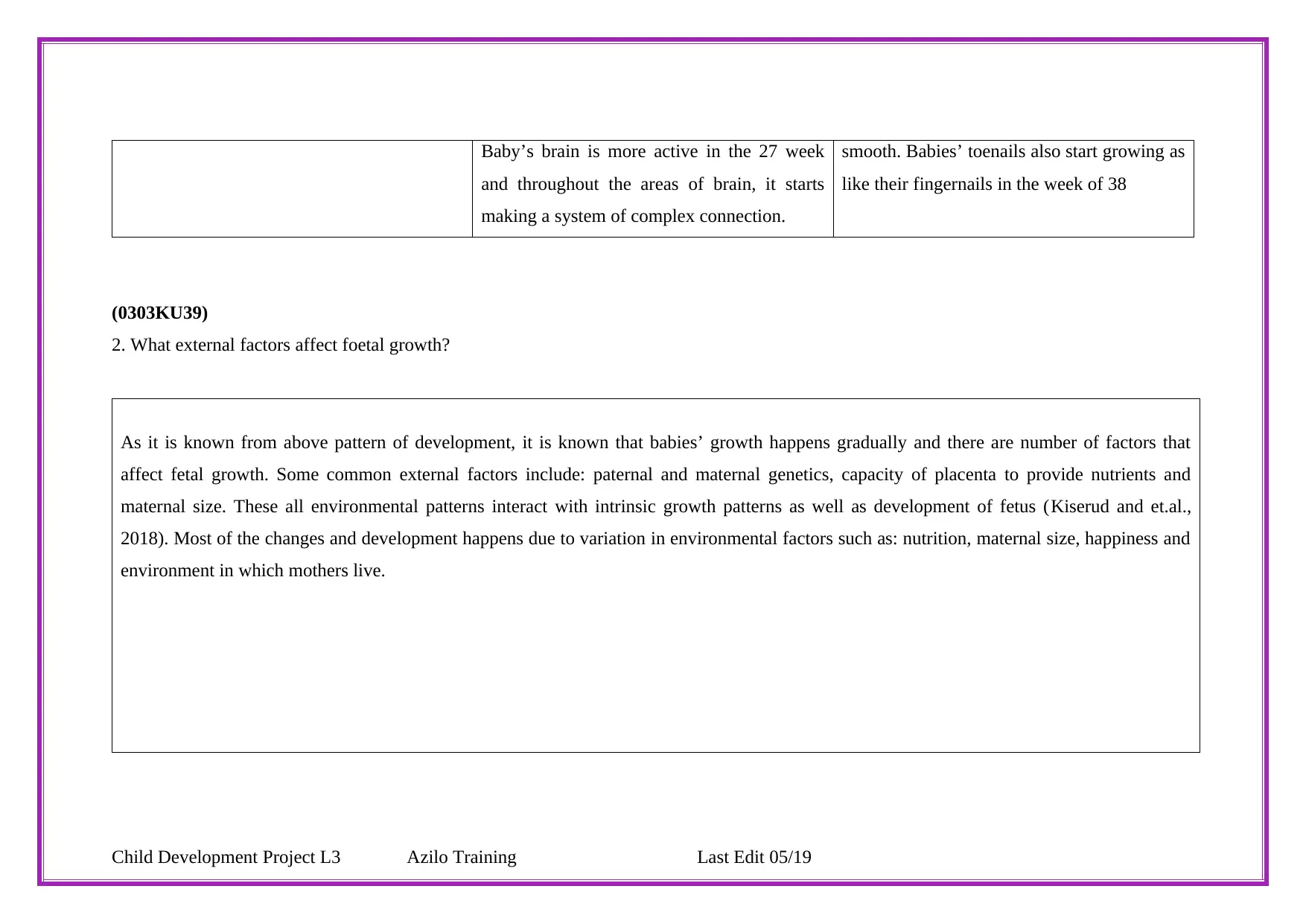
Baby’s brain is more active in the 27 week
and throughout the areas of brain, it starts
making a system of complex connection.
smooth. Babies’ toenails also start growing as
like their fingernails in the week of 38
(0303KU39)
2. What external factors affect foetal growth?
As it is known from above pattern of development, it is known that babies’ growth happens gradually and there are number of factors that
affect fetal growth. Some common external factors include: paternal and maternal genetics, capacity of placenta to provide nutrients and
maternal size. These all environmental patterns interact with intrinsic growth patterns as well as development of fetus (Kiserud and et.al.,
2018). Most of the changes and development happens due to variation in environmental factors such as: nutrition, maternal size, happiness and
environment in which mothers live.
Child Development Project L3 Azilo Training Last Edit 05/19
and throughout the areas of brain, it starts
making a system of complex connection.
smooth. Babies’ toenails also start growing as
like their fingernails in the week of 38
(0303KU39)
2. What external factors affect foetal growth?
As it is known from above pattern of development, it is known that babies’ growth happens gradually and there are number of factors that
affect fetal growth. Some common external factors include: paternal and maternal genetics, capacity of placenta to provide nutrients and
maternal size. These all environmental patterns interact with intrinsic growth patterns as well as development of fetus (Kiserud and et.al.,
2018). Most of the changes and development happens due to variation in environmental factors such as: nutrition, maternal size, happiness and
environment in which mothers live.
Child Development Project L3 Azilo Training Last Edit 05/19
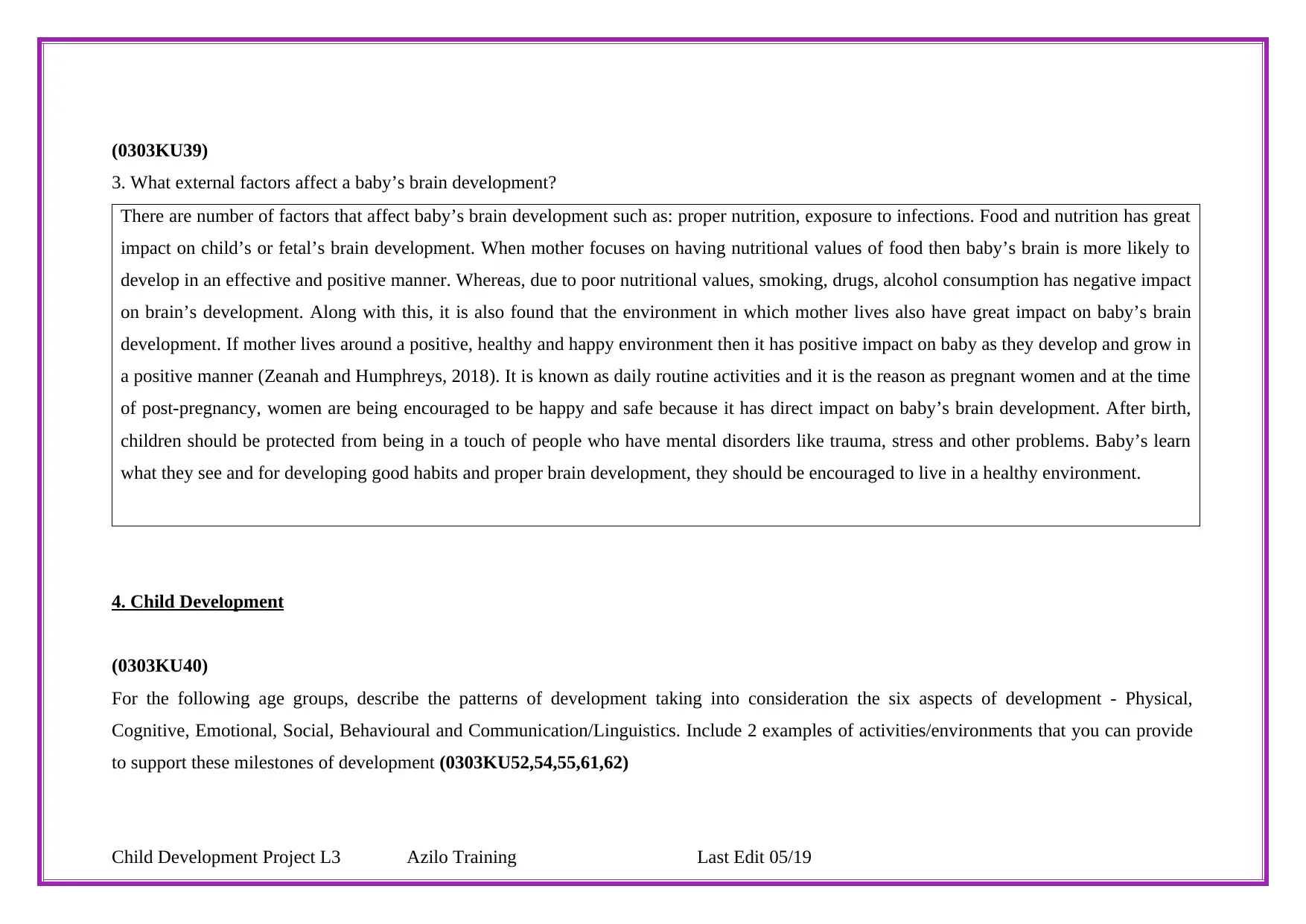
(0303KU39)
3. What external factors affect a baby’s brain development?
There are number of factors that affect baby’s brain development such as: proper nutrition, exposure to infections. Food and nutrition has great
impact on child’s or fetal’s brain development. When mother focuses on having nutritional values of food then baby’s brain is more likely to
develop in an effective and positive manner. Whereas, due to poor nutritional values, smoking, drugs, alcohol consumption has negative impact
on brain’s development. Along with this, it is also found that the environment in which mother lives also have great impact on baby’s brain
development. If mother lives around a positive, healthy and happy environment then it has positive impact on baby as they develop and grow in
a positive manner (Zeanah and Humphreys, 2018). It is known as daily routine activities and it is the reason as pregnant women and at the time
of post-pregnancy, women are being encouraged to be happy and safe because it has direct impact on baby’s brain development. After birth,
children should be protected from being in a touch of people who have mental disorders like trauma, stress and other problems. Baby’s learn
what they see and for developing good habits and proper brain development, they should be encouraged to live in a healthy environment.
4. Child Development
(0303KU40)
For the following age groups, describe the patterns of development taking into consideration the six aspects of development - Physical,
Cognitive, Emotional, Social, Behavioural and Communication/Linguistics. Include 2 examples of activities/environments that you can provide
to support these milestones of development (0303KU52,54,55,61,62)
Child Development Project L3 Azilo Training Last Edit 05/19
3. What external factors affect a baby’s brain development?
There are number of factors that affect baby’s brain development such as: proper nutrition, exposure to infections. Food and nutrition has great
impact on child’s or fetal’s brain development. When mother focuses on having nutritional values of food then baby’s brain is more likely to
develop in an effective and positive manner. Whereas, due to poor nutritional values, smoking, drugs, alcohol consumption has negative impact
on brain’s development. Along with this, it is also found that the environment in which mother lives also have great impact on baby’s brain
development. If mother lives around a positive, healthy and happy environment then it has positive impact on baby as they develop and grow in
a positive manner (Zeanah and Humphreys, 2018). It is known as daily routine activities and it is the reason as pregnant women and at the time
of post-pregnancy, women are being encouraged to be happy and safe because it has direct impact on baby’s brain development. After birth,
children should be protected from being in a touch of people who have mental disorders like trauma, stress and other problems. Baby’s learn
what they see and for developing good habits and proper brain development, they should be encouraged to live in a healthy environment.
4. Child Development
(0303KU40)
For the following age groups, describe the patterns of development taking into consideration the six aspects of development - Physical,
Cognitive, Emotional, Social, Behavioural and Communication/Linguistics. Include 2 examples of activities/environments that you can provide
to support these milestones of development (0303KU52,54,55,61,62)
Child Development Project L3 Azilo Training Last Edit 05/19
⊘ This is a preview!⊘
Do you want full access?
Subscribe today to unlock all pages.

Trusted by 1+ million students worldwide
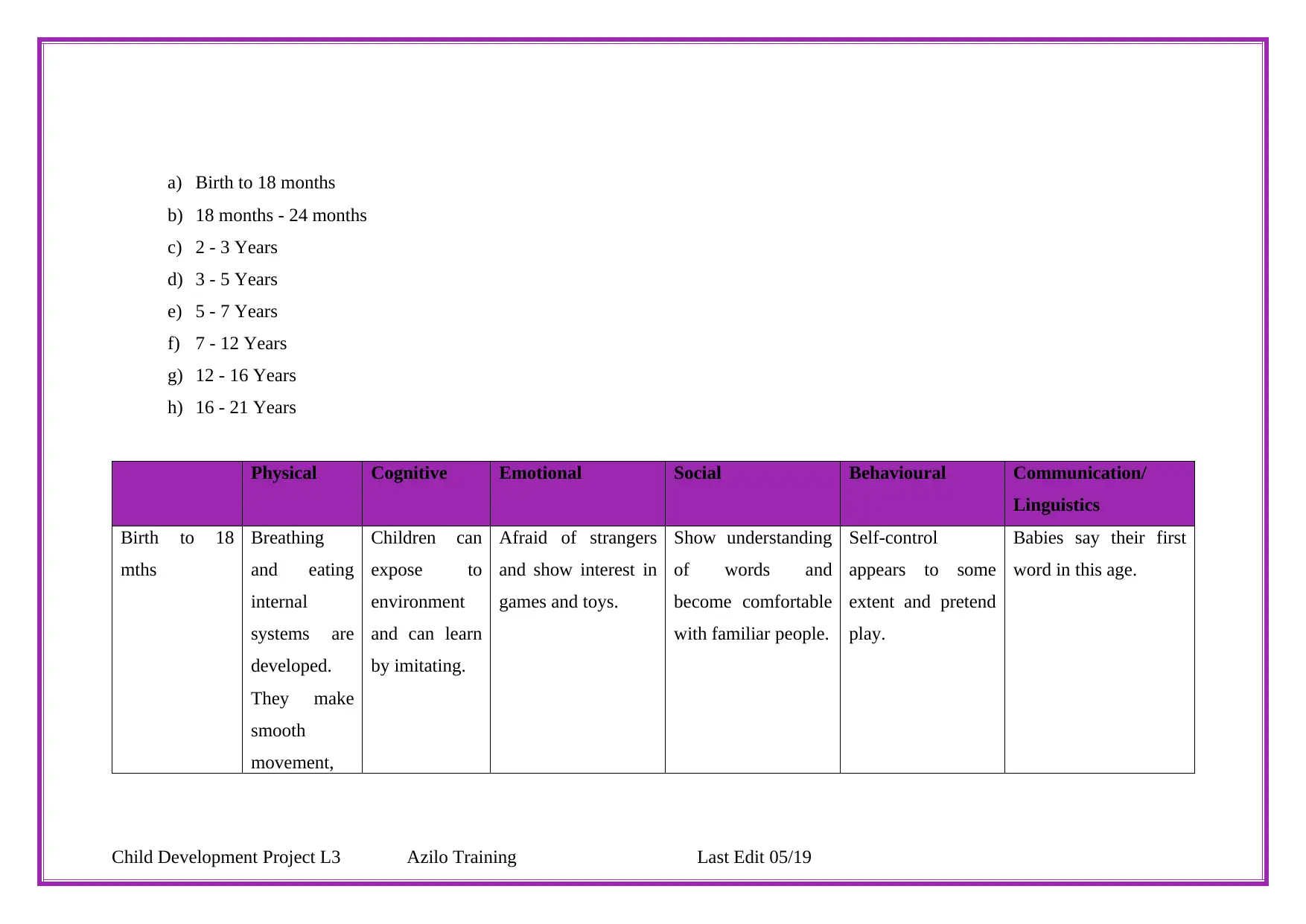
a) Birth to 18 months
b) 18 months - 24 months
c) 2 - 3 Years
d) 3 - 5 Years
e) 5 - 7 Years
f) 7 - 12 Years
g) 12 - 16 Years
h) 16 - 21 Years
Physical Cognitive Emotional Social Behavioural Communication/
Linguistics
Birth to 18
mths
Breathing
and eating
internal
systems are
developed.
They make
smooth
movement,
Children can
expose to
environment
and can learn
by imitating.
Afraid of strangers
and show interest in
games and toys.
Show understanding
of words and
become comfortable
with familiar people.
Self-control
appears to some
extent and pretend
play.
Babies say their first
word in this age.
Child Development Project L3 Azilo Training Last Edit 05/19
b) 18 months - 24 months
c) 2 - 3 Years
d) 3 - 5 Years
e) 5 - 7 Years
f) 7 - 12 Years
g) 12 - 16 Years
h) 16 - 21 Years
Physical Cognitive Emotional Social Behavioural Communication/
Linguistics
Birth to 18
mths
Breathing
and eating
internal
systems are
developed.
They make
smooth
movement,
Children can
expose to
environment
and can learn
by imitating.
Afraid of strangers
and show interest in
games and toys.
Show understanding
of words and
become comfortable
with familiar people.
Self-control
appears to some
extent and pretend
play.
Babies say their first
word in this age.
Child Development Project L3 Azilo Training Last Edit 05/19
Paraphrase This Document
Need a fresh take? Get an instant paraphrase of this document with our AI Paraphraser
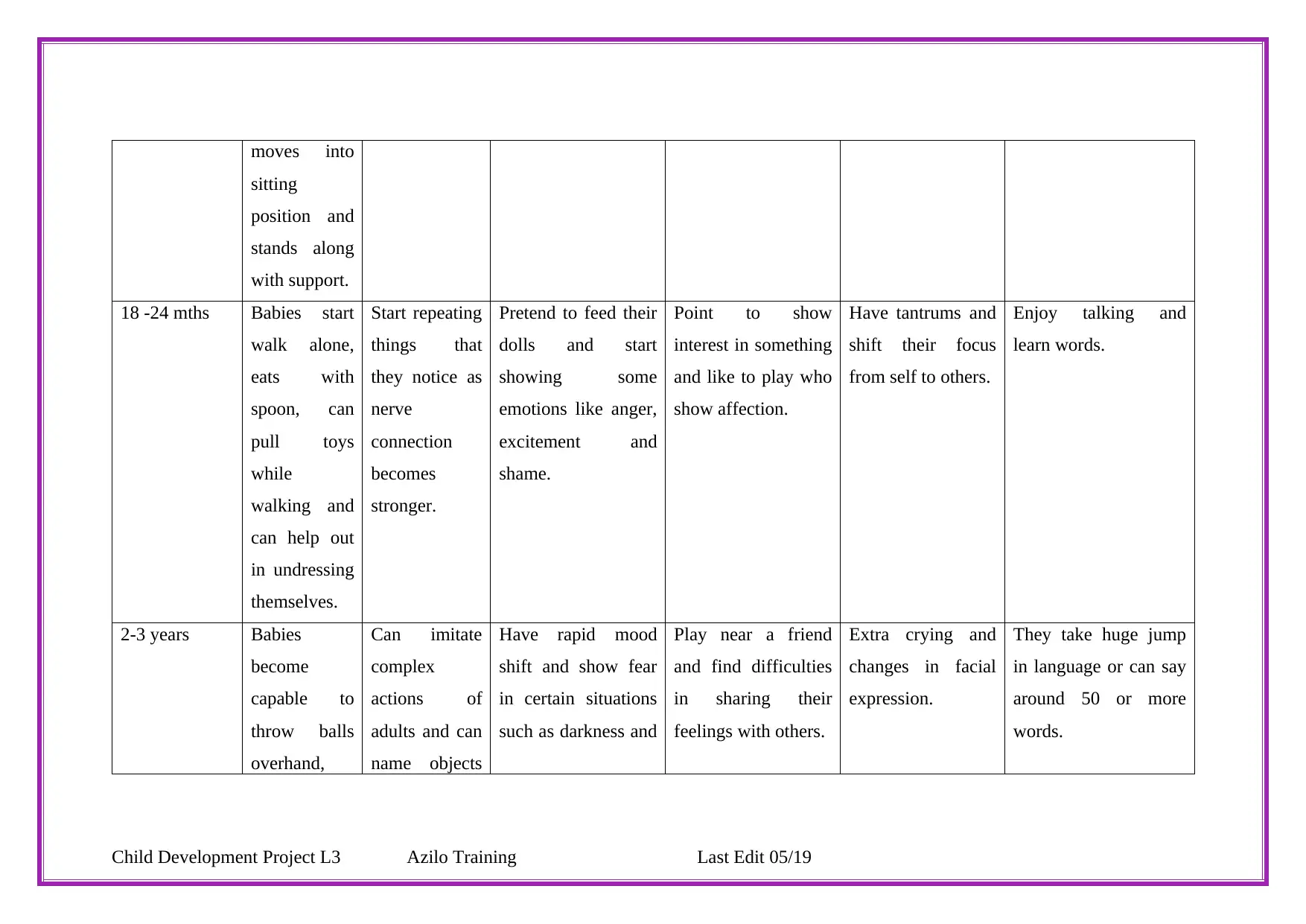
moves into
sitting
position and
stands along
with support.
18 -24 mths Babies start
walk alone,
eats with
spoon, can
pull toys
while
walking and
can help out
in undressing
themselves.
Start repeating
things that
they notice as
nerve
connection
becomes
stronger.
Pretend to feed their
dolls and start
showing some
emotions like anger,
excitement and
shame.
Point to show
interest in something
and like to play who
show affection.
Have tantrums and
shift their focus
from self to others.
Enjoy talking and
learn words.
2-3 years Babies
become
capable to
throw balls
overhand,
Can imitate
complex
actions of
adults and can
name objects
Have rapid mood
shift and show fear
in certain situations
such as darkness and
Play near a friend
and find difficulties
in sharing their
feelings with others.
Extra crying and
changes in facial
expression.
They take huge jump
in language or can say
around 50 or more
words.
Child Development Project L3 Azilo Training Last Edit 05/19
sitting
position and
stands along
with support.
18 -24 mths Babies start
walk alone,
eats with
spoon, can
pull toys
while
walking and
can help out
in undressing
themselves.
Start repeating
things that
they notice as
nerve
connection
becomes
stronger.
Pretend to feed their
dolls and start
showing some
emotions like anger,
excitement and
shame.
Point to show
interest in something
and like to play who
show affection.
Have tantrums and
shift their focus
from self to others.
Enjoy talking and
learn words.
2-3 years Babies
become
capable to
throw balls
overhand,
Can imitate
complex
actions of
adults and can
name objects
Have rapid mood
shift and show fear
in certain situations
such as darkness and
Play near a friend
and find difficulties
in sharing their
feelings with others.
Extra crying and
changes in facial
expression.
They take huge jump
in language or can say
around 50 or more
words.
Child Development Project L3 Azilo Training Last Edit 05/19
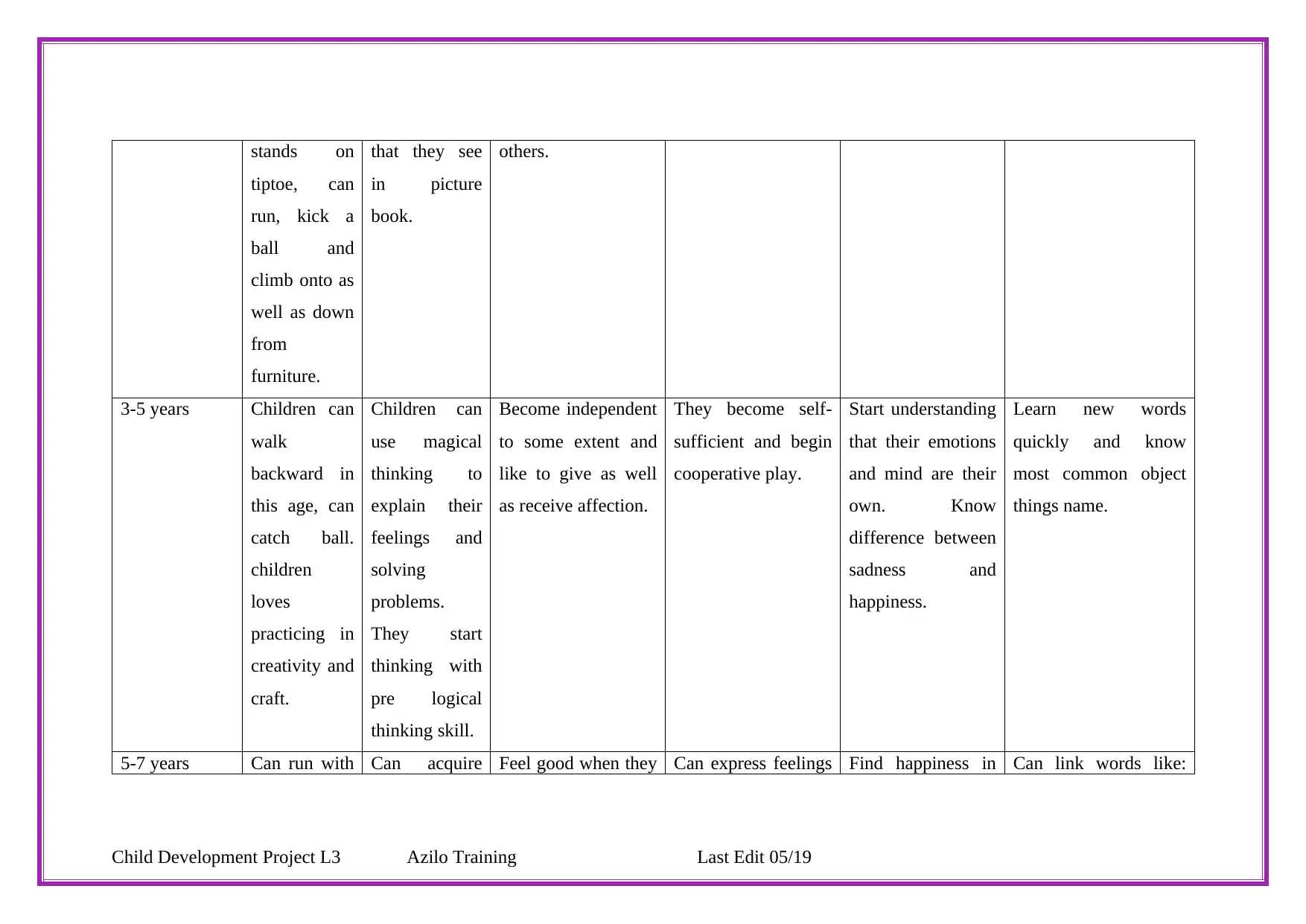
stands on
tiptoe, can
run, kick a
ball and
climb onto as
well as down
from
furniture.
that they see
in picture
book.
others.
3-5 years Children can
walk
backward in
this age, can
catch ball.
children
loves
practicing in
creativity and
craft.
Children can
use magical
thinking to
explain their
feelings and
solving
problems.
They start
thinking with
pre logical
thinking skill.
Become independent
to some extent and
like to give as well
as receive affection.
They become self-
sufficient and begin
cooperative play.
Start understanding
that their emotions
and mind are their
own. Know
difference between
sadness and
happiness.
Learn new words
quickly and know
most common object
things name.
5-7 years Can run with Can acquire Feel good when they Can express feelings Find happiness in Can link words like:
Child Development Project L3 Azilo Training Last Edit 05/19
tiptoe, can
run, kick a
ball and
climb onto as
well as down
from
furniture.
that they see
in picture
book.
others.
3-5 years Children can
walk
backward in
this age, can
catch ball.
children
loves
practicing in
creativity and
craft.
Children can
use magical
thinking to
explain their
feelings and
solving
problems.
They start
thinking with
pre logical
thinking skill.
Become independent
to some extent and
like to give as well
as receive affection.
They become self-
sufficient and begin
cooperative play.
Start understanding
that their emotions
and mind are their
own. Know
difference between
sadness and
happiness.
Learn new words
quickly and know
most common object
things name.
5-7 years Can run with Can acquire Feel good when they Can express feelings Find happiness in Can link words like:
Child Development Project L3 Azilo Training Last Edit 05/19
⊘ This is a preview!⊘
Do you want full access?
Subscribe today to unlock all pages.

Trusted by 1+ million students worldwide
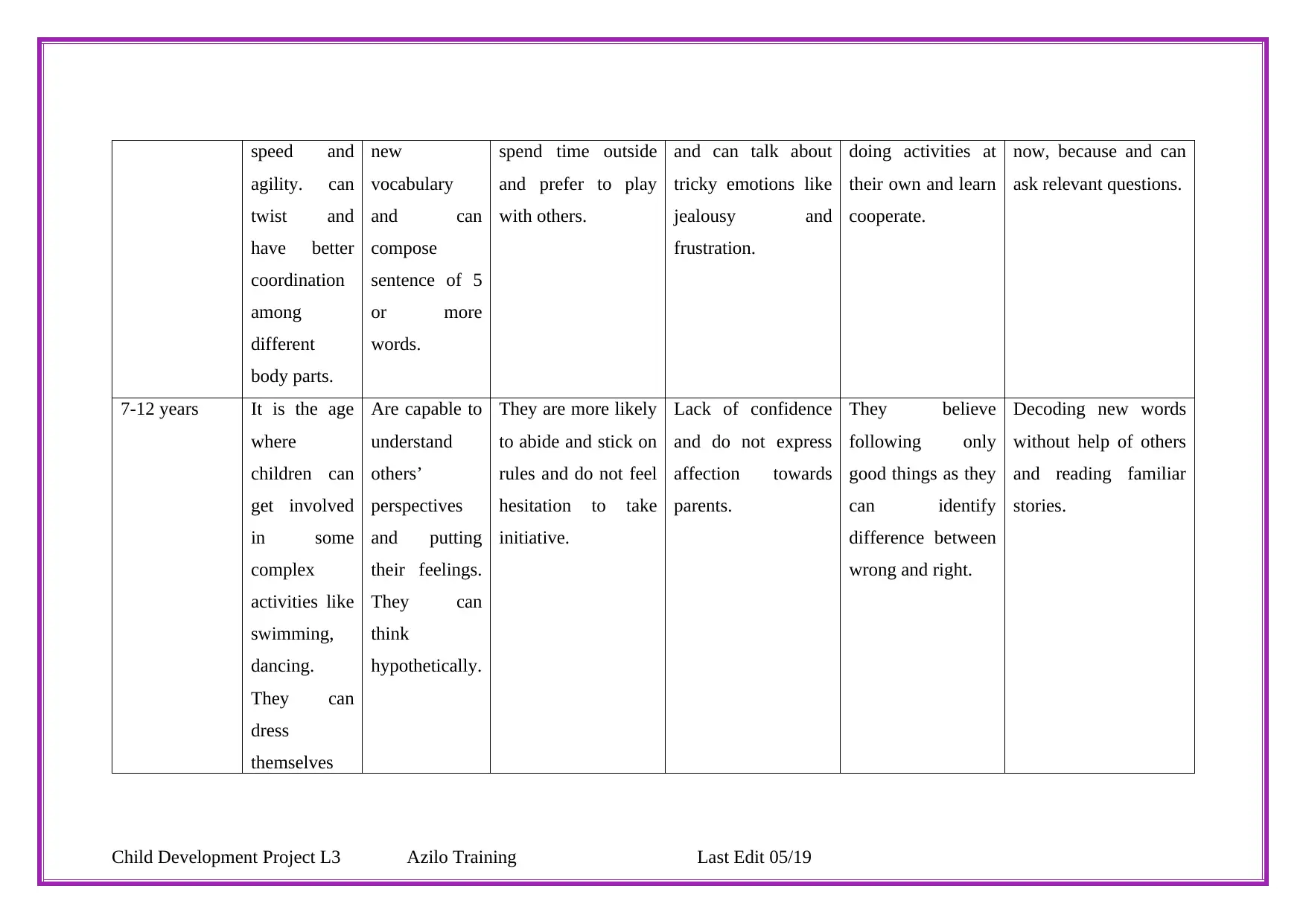
speed and
agility. can
twist and
have better
coordination
among
different
body parts.
new
vocabulary
and can
compose
sentence of 5
or more
words.
spend time outside
and prefer to play
with others.
and can talk about
tricky emotions like
jealousy and
frustration.
doing activities at
their own and learn
cooperate.
now, because and can
ask relevant questions.
7-12 years It is the age
where
children can
get involved
in some
complex
activities like
swimming,
dancing.
They can
dress
themselves
Are capable to
understand
others’
perspectives
and putting
their feelings.
They can
think
hypothetically.
They are more likely
to abide and stick on
rules and do not feel
hesitation to take
initiative.
Lack of confidence
and do not express
affection towards
parents.
They believe
following only
good things as they
can identify
difference between
wrong and right.
Decoding new words
without help of others
and reading familiar
stories.
Child Development Project L3 Azilo Training Last Edit 05/19
agility. can
twist and
have better
coordination
among
different
body parts.
new
vocabulary
and can
compose
sentence of 5
or more
words.
spend time outside
and prefer to play
with others.
and can talk about
tricky emotions like
jealousy and
frustration.
doing activities at
their own and learn
cooperate.
now, because and can
ask relevant questions.
7-12 years It is the age
where
children can
get involved
in some
complex
activities like
swimming,
dancing.
They can
dress
themselves
Are capable to
understand
others’
perspectives
and putting
their feelings.
They can
think
hypothetically.
They are more likely
to abide and stick on
rules and do not feel
hesitation to take
initiative.
Lack of confidence
and do not express
affection towards
parents.
They believe
following only
good things as they
can identify
difference between
wrong and right.
Decoding new words
without help of others
and reading familiar
stories.
Child Development Project L3 Azilo Training Last Edit 05/19
Paraphrase This Document
Need a fresh take? Get an instant paraphrase of this document with our AI Paraphraser
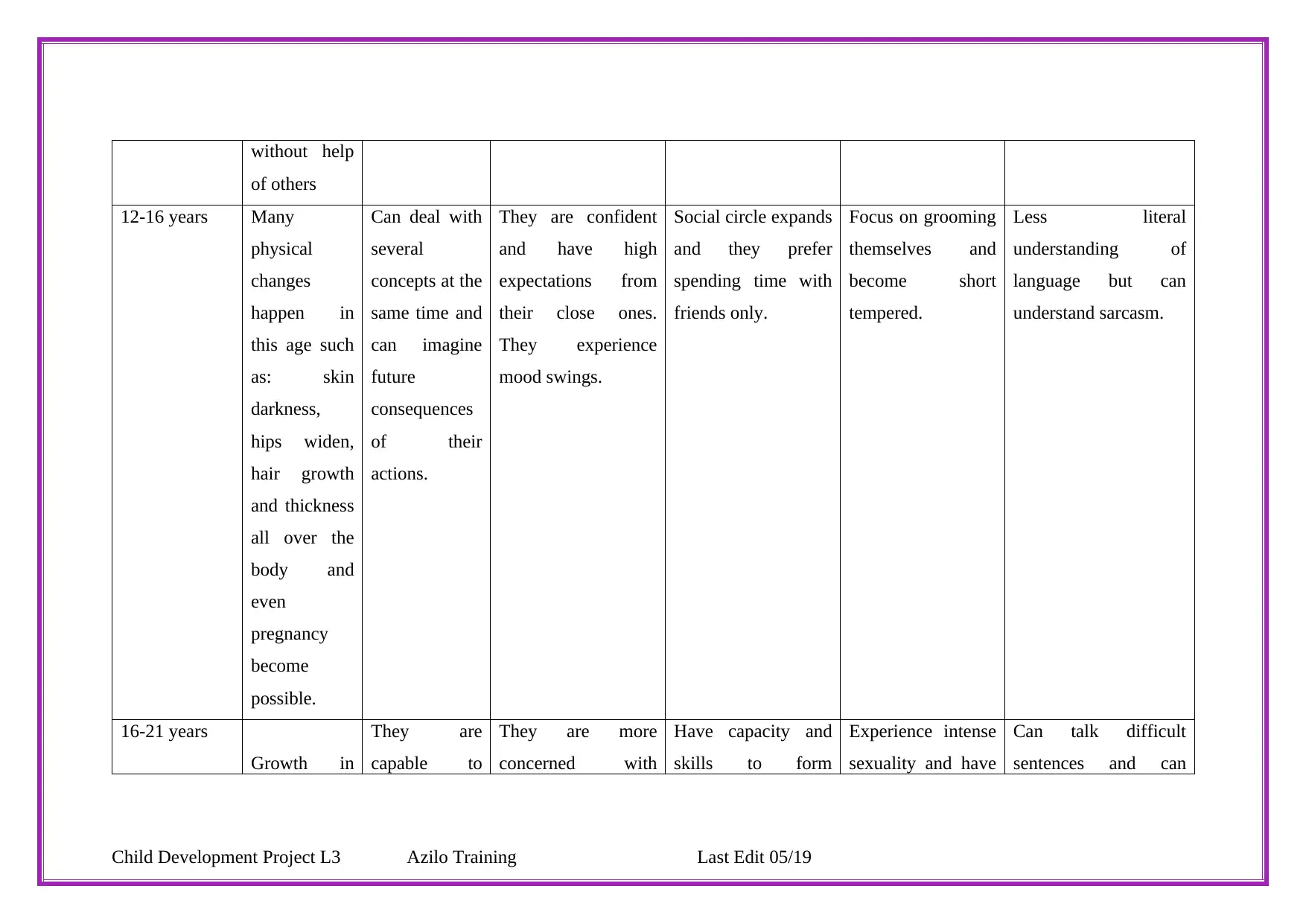
without help
of others
12-16 years Many
physical
changes
happen in
this age such
as: skin
darkness,
hips widen,
hair growth
and thickness
all over the
body and
even
pregnancy
become
possible.
Can deal with
several
concepts at the
same time and
can imagine
future
consequences
of their
actions.
They are confident
and have high
expectations from
their close ones.
They experience
mood swings.
Social circle expands
and they prefer
spending time with
friends only.
Focus on grooming
themselves and
become short
tempered.
Less literal
understanding of
language but can
understand sarcasm.
16-21 years
Growth in
They are
capable to
They are more
concerned with
Have capacity and
skills to form
Experience intense
sexuality and have
Can talk difficult
sentences and can
Child Development Project L3 Azilo Training Last Edit 05/19
of others
12-16 years Many
physical
changes
happen in
this age such
as: skin
darkness,
hips widen,
hair growth
and thickness
all over the
body and
even
pregnancy
become
possible.
Can deal with
several
concepts at the
same time and
can imagine
future
consequences
of their
actions.
They are confident
and have high
expectations from
their close ones.
They experience
mood swings.
Social circle expands
and they prefer
spending time with
friends only.
Focus on grooming
themselves and
become short
tempered.
Less literal
understanding of
language but can
understand sarcasm.
16-21 years
Growth in
They are
capable to
They are more
concerned with
Have capacity and
skills to form
Experience intense
sexuality and have
Can talk difficult
sentences and can
Child Development Project L3 Azilo Training Last Edit 05/19
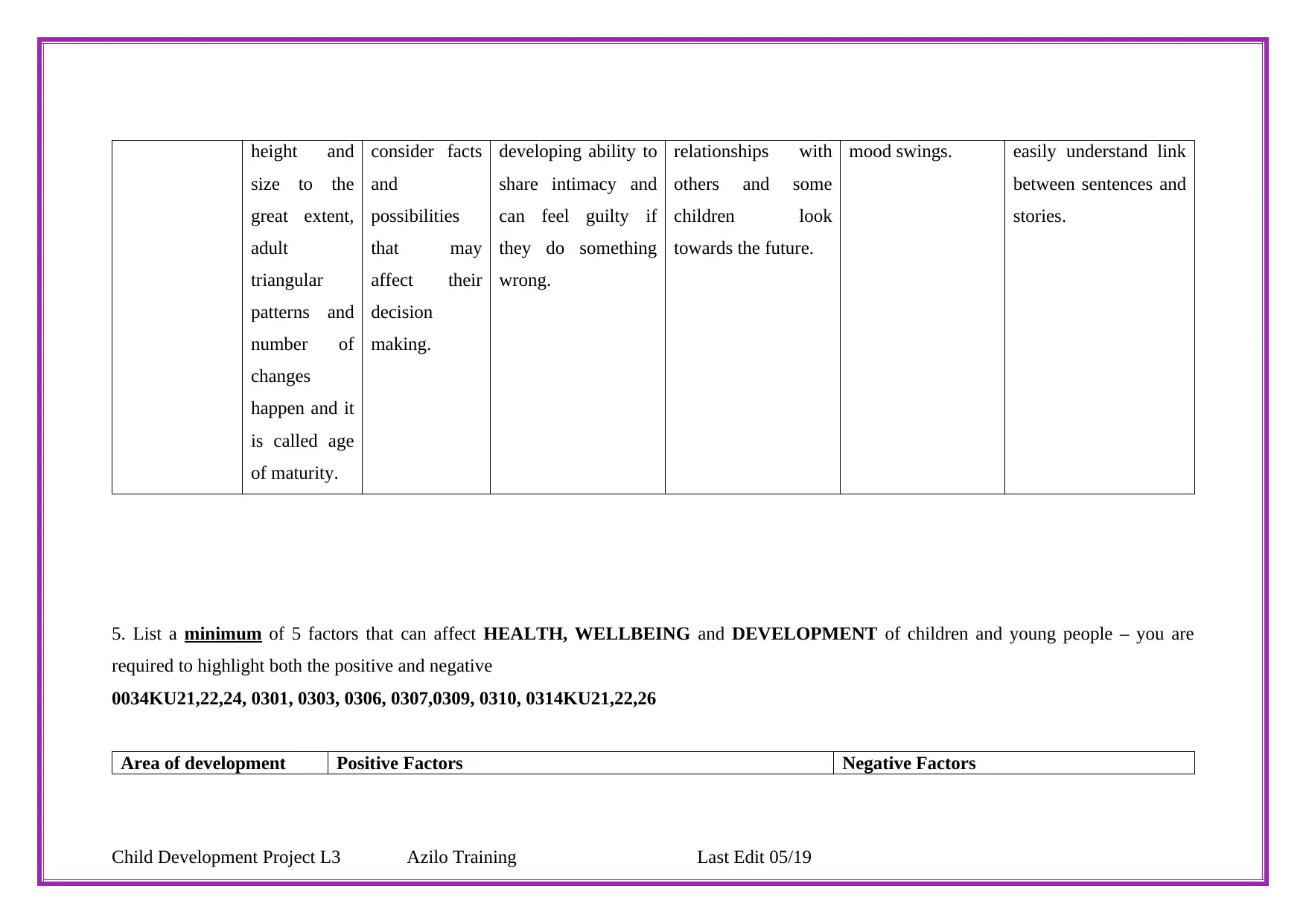
height and
size to the
great extent,
adult
triangular
patterns and
number of
changes
happen and it
is called age
of maturity.
consider facts
and
possibilities
that may
affect their
decision
making.
developing ability to
share intimacy and
can feel guilty if
they do something
wrong.
relationships with
others and some
children look
towards the future.
mood swings. easily understand link
between sentences and
stories.
5. List a minimum of 5 factors that can affect HEALTH, WELLBEING and DEVELOPMENT of children and young people – you are
required to highlight both the positive and negative
0034KU21,22,24, 0301, 0303, 0306, 0307,0309, 0310, 0314KU21,22,26
Area of development Positive Factors Negative Factors
Child Development Project L3 Azilo Training Last Edit 05/19
size to the
great extent,
adult
triangular
patterns and
number of
changes
happen and it
is called age
of maturity.
consider facts
and
possibilities
that may
affect their
decision
making.
developing ability to
share intimacy and
can feel guilty if
they do something
wrong.
relationships with
others and some
children look
towards the future.
mood swings. easily understand link
between sentences and
stories.
5. List a minimum of 5 factors that can affect HEALTH, WELLBEING and DEVELOPMENT of children and young people – you are
required to highlight both the positive and negative
0034KU21,22,24, 0301, 0303, 0306, 0307,0309, 0310, 0314KU21,22,26
Area of development Positive Factors Negative Factors
Child Development Project L3 Azilo Training Last Edit 05/19
⊘ This is a preview!⊘
Do you want full access?
Subscribe today to unlock all pages.

Trusted by 1+ million students worldwide
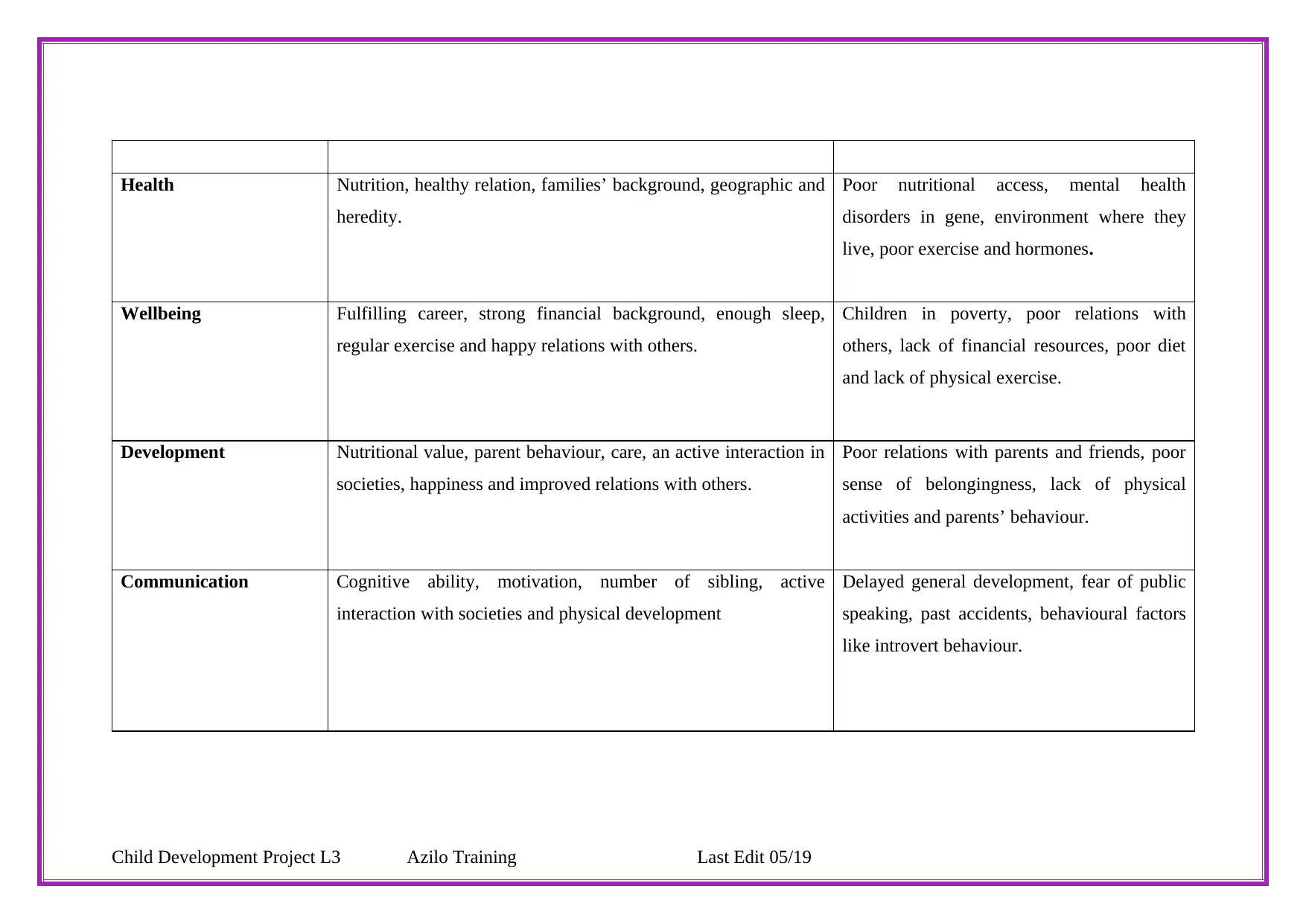
Health Nutrition, healthy relation, families’ background, geographic and
heredity.
Poor nutritional access, mental health
disorders in gene, environment where they
live, poor exercise and hormones.
Wellbeing Fulfilling career, strong financial background, enough sleep,
regular exercise and happy relations with others.
Children in poverty, poor relations with
others, lack of financial resources, poor diet
and lack of physical exercise.
Development Nutritional value, parent behaviour, care, an active interaction in
societies, happiness and improved relations with others.
Poor relations with parents and friends, poor
sense of belongingness, lack of physical
activities and parents’ behaviour.
Communication Cognitive ability, motivation, number of sibling, active
interaction with societies and physical development
Delayed general development, fear of public
speaking, past accidents, behavioural factors
like introvert behaviour.
Child Development Project L3 Azilo Training Last Edit 05/19
heredity.
Poor nutritional access, mental health
disorders in gene, environment where they
live, poor exercise and hormones.
Wellbeing Fulfilling career, strong financial background, enough sleep,
regular exercise and happy relations with others.
Children in poverty, poor relations with
others, lack of financial resources, poor diet
and lack of physical exercise.
Development Nutritional value, parent behaviour, care, an active interaction in
societies, happiness and improved relations with others.
Poor relations with parents and friends, poor
sense of belongingness, lack of physical
activities and parents’ behaviour.
Communication Cognitive ability, motivation, number of sibling, active
interaction with societies and physical development
Delayed general development, fear of public
speaking, past accidents, behavioural factors
like introvert behaviour.
Child Development Project L3 Azilo Training Last Edit 05/19
Paraphrase This Document
Need a fresh take? Get an instant paraphrase of this document with our AI Paraphraser
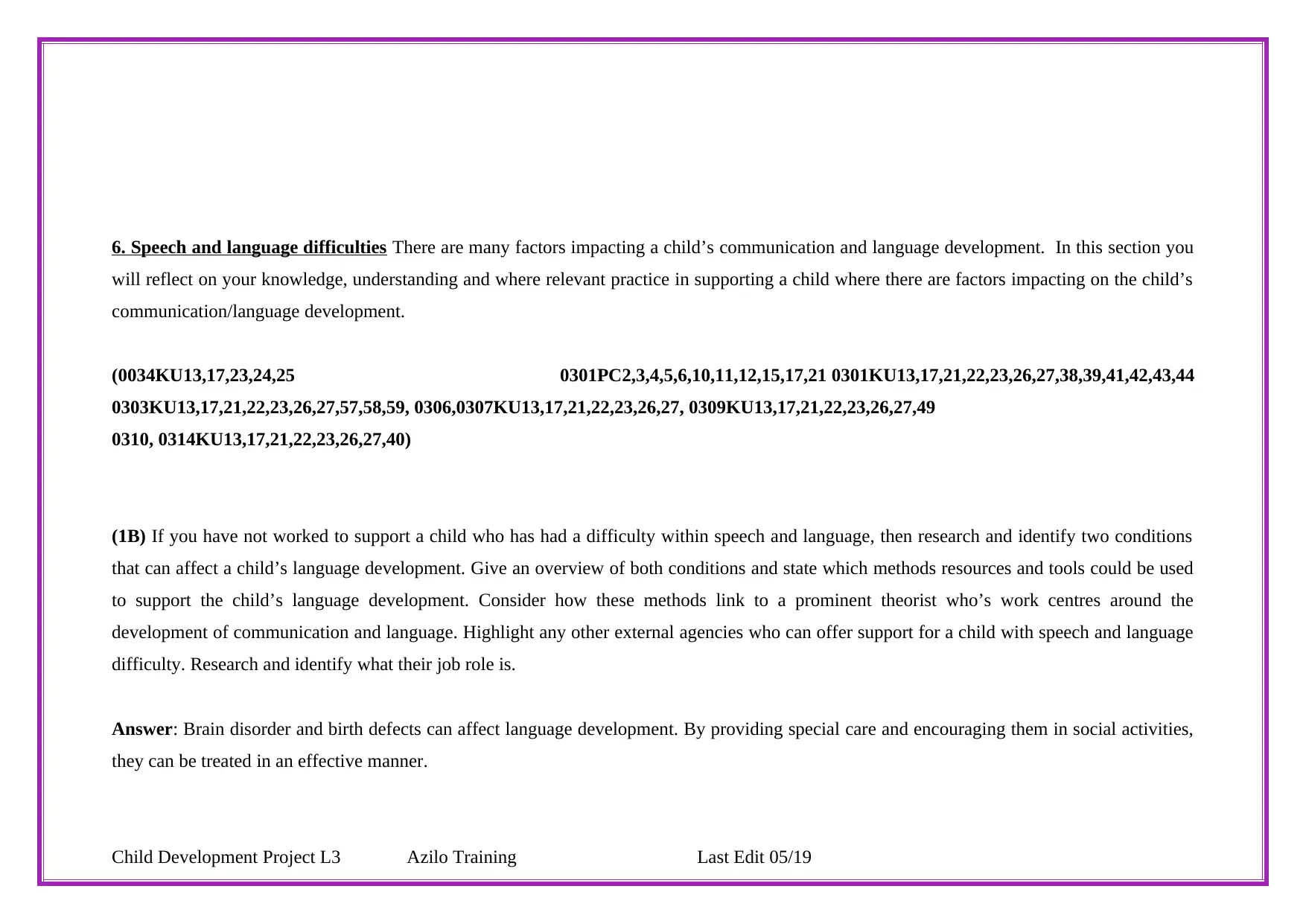
6. Speech and language difficulties There are many factors impacting a child’s communication and language development. In this section you
will reflect on your knowledge, understanding and where relevant practice in supporting a child where there are factors impacting on the child’s
communication/language development.
(0034KU13,17,23,24,25 0301PC2,3,4,5,6,10,11,12,15,17,21 0301KU13,17,21,22,23,26,27,38,39,41,42,43,44
0303KU13,17,21,22,23,26,27,57,58,59, 0306,0307KU13,17,21,22,23,26,27, 0309KU13,17,21,22,23,26,27,49
0310, 0314KU13,17,21,22,23,26,27,40)
(1B) If you have not worked to support a child who has had a difficulty within speech and language, then research and identify two conditions
that can affect a child’s language development. Give an overview of both conditions and state which methods resources and tools could be used
to support the child’s language development. Consider how these methods link to a prominent theorist who’s work centres around the
development of communication and language. Highlight any other external agencies who can offer support for a child with speech and language
difficulty. Research and identify what their job role is.
Answer: Brain disorder and birth defects can affect language development. By providing special care and encouraging them in social activities,
they can be treated in an effective manner.
Child Development Project L3 Azilo Training Last Edit 05/19
will reflect on your knowledge, understanding and where relevant practice in supporting a child where there are factors impacting on the child’s
communication/language development.
(0034KU13,17,23,24,25 0301PC2,3,4,5,6,10,11,12,15,17,21 0301KU13,17,21,22,23,26,27,38,39,41,42,43,44
0303KU13,17,21,22,23,26,27,57,58,59, 0306,0307KU13,17,21,22,23,26,27, 0309KU13,17,21,22,23,26,27,49
0310, 0314KU13,17,21,22,23,26,27,40)
(1B) If you have not worked to support a child who has had a difficulty within speech and language, then research and identify two conditions
that can affect a child’s language development. Give an overview of both conditions and state which methods resources and tools could be used
to support the child’s language development. Consider how these methods link to a prominent theorist who’s work centres around the
development of communication and language. Highlight any other external agencies who can offer support for a child with speech and language
difficulty. Research and identify what their job role is.
Answer: Brain disorder and birth defects can affect language development. By providing special care and encouraging them in social activities,
they can be treated in an effective manner.
Child Development Project L3 Azilo Training Last Edit 05/19
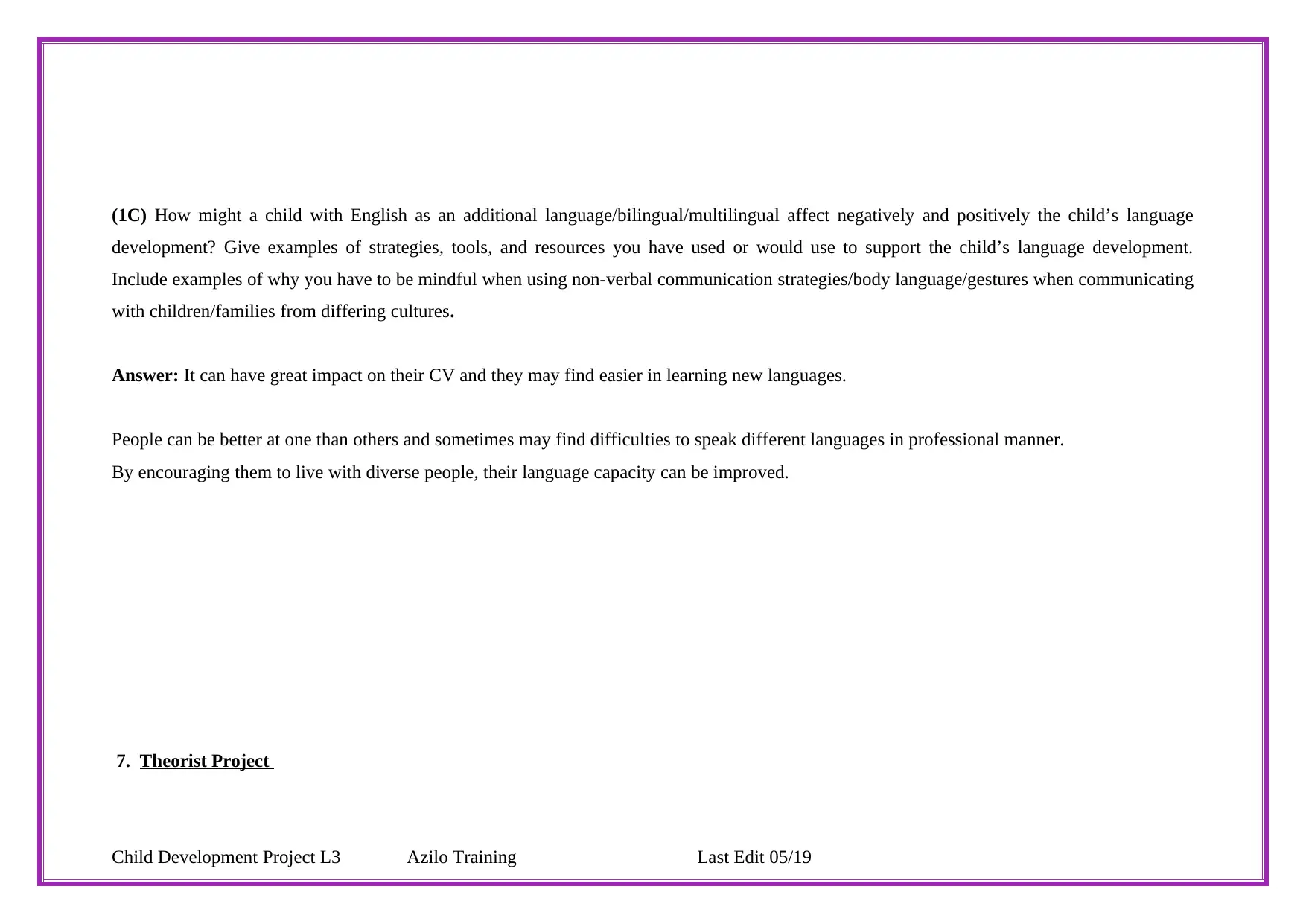
(1C) How might a child with English as an additional language/bilingual/multilingual affect negatively and positively the child’s language
development? Give examples of strategies, tools, and resources you have used or would use to support the child’s language development.
Include examples of why you have to be mindful when using non-verbal communication strategies/body language/gestures when communicating
with children/families from differing cultures.
Answer: It can have great impact on their CV and they may find easier in learning new languages.
People can be better at one than others and sometimes may find difficulties to speak different languages in professional manner.
By encouraging them to live with diverse people, their language capacity can be improved.
7. Theorist Project
Child Development Project L3 Azilo Training Last Edit 05/19
development? Give examples of strategies, tools, and resources you have used or would use to support the child’s language development.
Include examples of why you have to be mindful when using non-verbal communication strategies/body language/gestures when communicating
with children/families from differing cultures.
Answer: It can have great impact on their CV and they may find easier in learning new languages.
People can be better at one than others and sometimes may find difficulties to speak different languages in professional manner.
By encouraging them to live with diverse people, their language capacity can be improved.
7. Theorist Project
Child Development Project L3 Azilo Training Last Edit 05/19
⊘ This is a preview!⊘
Do you want full access?
Subscribe today to unlock all pages.

Trusted by 1+ million students worldwide
1 out of 22
Related Documents
Your All-in-One AI-Powered Toolkit for Academic Success.
+13062052269
info@desklib.com
Available 24*7 on WhatsApp / Email
![[object Object]](/_next/static/media/star-bottom.7253800d.svg)
Unlock your academic potential
Copyright © 2020–2025 A2Z Services. All Rights Reserved. Developed and managed by ZUCOL.




